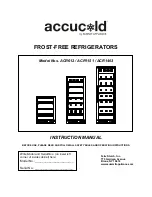
Helpful hints and tips
Energy saving tips
We recommend that you follow the tips below to save energy.
• Try to avoid keeping the door open for long periods in order to con-
serve energy.
• Ensure the appliance is away from any sources of heat. (Direct sun-
light, electric oven or cooker etc.)
• Don’t set the temperature colder than necessary.
• Don’t store warm food or evaporating liquid in the appliance.
• Place the appliance in a well ventilated, humidity free, room. Please
refer to Installing your new appliance chapter.
• If the diagram shows the correct combination for the drawers,
crisper and shelves, do not adjust the combination as this is desig-
ned to be the most energy efficient configuration
Hints for fresh food refrigeration
• Do not place hot food directly into the refrigerator, the internal
temperature will increase resulting in the compressor hav- ing to
work harder and will consume more energy.
• Do cover or wrap the food, particularly if it has a strong flavor.
• Place food properly so that air can circulate freely around it.
Hints for refrigeration
• Meat (All Types) Wrap in polythene food: Wrap and place on the
glass shelf above the vegetable drawer . Always follow food storage
times and use by dates suggested by manufacturers .
• Cooked food, cold dishes, etc.: They should be covered and may be
placed on any shelf .
• Fruit and vegetables: They should be stored in the special drawer
provided.
• Sutterand cheese: Should be wrapped in airtight foil or plastic film
wrap.
• Milk bott les : Should have a lid and be stored in the door racks.
Hints for the storage of frozen food
• Ensure that frozen food has been stored correctly by the food re-
tailer.
• Once defrosted, food will deteriorate rapidly and should not be re-
frozen. Do not exceed the storage period indicated by the food ma-
nufacturer.
Switching off your appliance
If the appliance needs to be switched off for an extended period, the
following steps should be taken prevent mould on the ap- pliance.
1 Remove all food.
2 Remove the power plug from the mains socket.
3 Clean and dry the interior thoroughly.
4 Ensure that all the doors are wedged open slightly to allow air to
circulate.
Cleaning and care
For hygienic reasons the appliance (including exterior and inte- rior ac-
cessories) should be cleaned regularly at least every two months.
Caution!
The appliance must not be connected to the mains during
cleaning. Danger of electrical shock! Before cleaning switch the appli-
ance off and remove the plug from the mains socket.
Exterior cleaning
• To maintain good appearance of your appliance, you should clean
it regularly.
• Wipe the digital panel and display panel with a clean, soft cloth.
• Spray water onto the cleaning cloth instead of spraying directly on
the surface of the appliance. This helps ensure an even distribution
of moisture to the surface.
• Clean the doors, handles and cabinet surfaces with a mild detergent
and then wiped dry with a soft cloth.
Caution!
• Don’t use sharp objects as they are likely to scratch the surface.
• Don’t use Thinner, Car detergent, Clorox, ethereal oil, abrasive
cleansers or organic solvent such as Benzene for cleaning. They may
damage the surface of the appliance and may cause fire.
Interior cleaning
• You should clean the appliance interior regularly. It will be easier to
clean when food stocks are low.
• Wipe the inside of the refrigerator with a weak solution of bicarbo-
nate of soda, and then rinse with warm water using a wrung-out
sponge or cloth.
• Wipe completely dry before replacing the shelves and baskets. Tho-
roughly dry all surfaces and removable parts. Although this appli-
ance automatically defrosts, a layer of frost may occur on the re-
frigerator’s interior walls if the door is opened frequently or kept
open too long. If the frost is too thick, choose a time when the sup-
ply of food stocks are low and proceed as follows:
• Remove existing food and accessories baskets, unplug the appli-
ance from the mains power and leave the doors open. Ventilate the
room thoroughly to accelerate the thawing process.
•
Caution!
Don’t use sharp objects to remove frost from the refrige-
rator. Only after the interior is completely dry should the appliance
be switched back on and plugged back into the mains socket.
Door seal cleaning
• Take care to keep door seals clean. Sticky food and drinks can cause
seals to stick to the cabinet and tear when you open the door. Wash
seal with a mild detergent and warm water. Rinse and dry it tho-
roughly after cleaning.
•
Caution!
Only after the door seals are completely dry should the
appliance be powered on.
Replacing the LED light
Warning:
The LED light must not be replaced by the user! lf the LED light
is damaged , contact the customer helpline for assistance. To replace the
LED light, the below steps can be followed:
1 Unplug your appliance.
2 Remove light cover by pushing up and out.
3 Hold the LED cover with one hand and pull it with the other hand
while pressing the connector latch.
4 Replace LED light and snap it correctly in place.
Troubleshooting
If you experience a problem with your appliance or are concerned that
the appliance is not functioning correctly, you can carry out some easy
checks before calling for service, please see below. You can carry out
some easy checks according to this section before calling for service.
Warning! Don’t try to repair the appliance yourself. If the problem per-
sists after you have made the checks mentioned below, contact a quali-
fied electrician, authorized service engineer or the shop where you pur-
chased the product.
















































